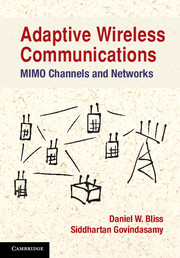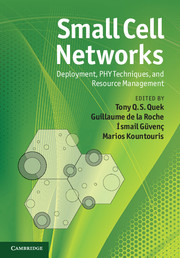Refine search
Actions for selected content:
6791 results in Communications and signal processing
Preface
-
- Book:
- Adaptive Wireless Communications
- Published online:
- 05 May 2013
- Print publication:
- 09 May 2013, pp xvii-xvii
-
- Chapter
- Export citation
13 - Cellular networks
-
- Book:
- Adaptive Wireless Communications
- Published online:
- 05 May 2013
- Print publication:
- 09 May 2013, pp 414-469
-
- Chapter
- Export citation
1 - History
-
- Book:
- Adaptive Wireless Communications
- Published online:
- 05 May 2013
- Print publication:
- 09 May 2013, pp 1-11
-
- Chapter
- Export citation

Adaptive Wireless Communications
-
- Published online:
- 05 May 2013
- Print publication:
- 09 May 2013

Small Cell Networks
- Deployment, PHY Techniques, and Resource Management
-
- Published online:
- 05 May 2013
- Print publication:
- 02 May 2013
3 - Coverage analysis using the Poisson point process model
-
-
- Book:
- Small Cell Networks
- Published online:
- 05 May 2013
- Print publication:
- 02 May 2013, pp 44-81
-
- Chapter
- Export citation
Index
-
- Book:
- Small Cell Networks
- Published online:
- 05 May 2013
- Print publication:
- 02 May 2013, pp 412-416
-
- Chapter
- Export citation
8 - Random matrix methods for cooperation in small cell networks
-
-
- Book:
- Small Cell Networks
- Published online:
- 05 May 2013
- Print publication:
- 02 May 2013, pp 188-218
-
- Chapter
- Export citation
Contents
-
- Book:
- Small Cell Networks
- Published online:
- 05 May 2013
- Print publication:
- 02 May 2013, pp v-xiii
-
- Chapter
- Export citation
Acronyms
-
- Book:
- Small Cell Networks
- Published online:
- 05 May 2013
- Print publication:
- 02 May 2013, pp xix-xxiv
-
- Chapter
- Export citation
Foreword by David Chambers
-
-
- Book:
- Small Cell Networks
- Published online:
- 05 May 2013
- Print publication:
- 02 May 2013, pp xvii-xvii
-
- Chapter
- Export citation
15 - Spectrum assignment and fairness in femtocell networks
-
-
- Book:
- Small Cell Networks
- Published online:
- 05 May 2013
- Print publication:
- 02 May 2013, pp 357-382
-
- Chapter
- Export citation
10 - Cognitive radio resource management in autonomous femtocell networks
-
-
- Book:
- Small Cell Networks
- Published online:
- 05 May 2013
- Print publication:
- 02 May 2013, pp 246-259
-
- Chapter
- Export citation
11 - Decentralized reinforcement learning techniques for interference management in heterogeneous networks
-
-
- Book:
- Small Cell Networks
- Published online:
- 05 May 2013
- Print publication:
- 02 May 2013, pp 260-279
-
- Chapter
- Export citation
6 - Physical layer techniques for cognitive femtocells
-
-
- Book:
- Small Cell Networks
- Published online:
- 05 May 2013
- Print publication:
- 02 May 2013, pp 125-160
-
- Chapter
- Export citation
13 - New strategies for femto-macro cellular interference control
-
-
- Book:
- Small Cell Networks
- Published online:
- 05 May 2013
- Print publication:
- 02 May 2013, pp 311-331
-
- Chapter
- Export citation
14 - Femtocell interference control in standardization
-
-
- Book:
- Small Cell Networks
- Published online:
- 05 May 2013
- Print publication:
- 02 May 2013, pp 332-356
-
- Chapter
- Export citation
Acknowledgments
-
- Book:
- Small Cell Networks
- Published online:
- 05 May 2013
- Print publication:
- 02 May 2013, pp xviii-xviii
-
- Chapter
- Export citation
16 - Self-organization and interference avoidance for LTE femtocells
-
-
- Book:
- Small Cell Networks
- Published online:
- 05 May 2013
- Print publication:
- 02 May 2013, pp 383-411
-
- Chapter
- Export citation
9 - Mobility in small cell networks
-
-
- Book:
- Small Cell Networks
- Published online:
- 05 May 2013
- Print publication:
- 02 May 2013, pp 219-245
-
- Chapter
- Export citation
